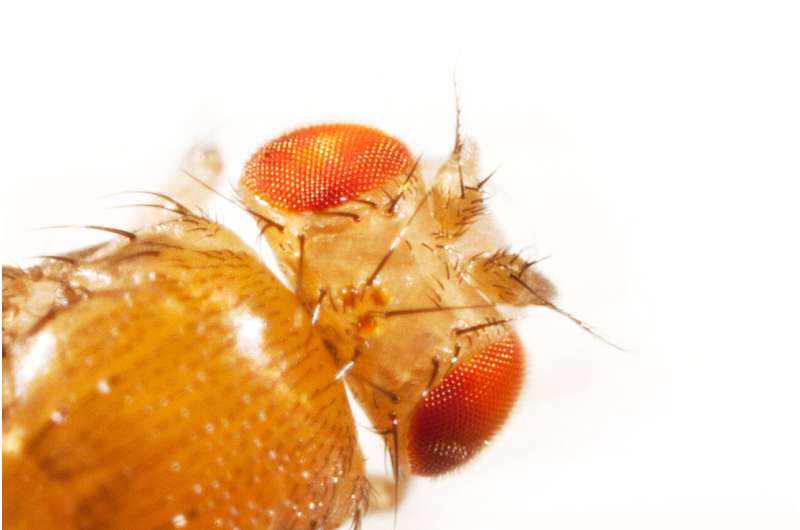May 5, 2020 feature
FLIVVER: An insect-inspired algorithm to estimate the velocity of flying robots

Nature is one of the most valuable sources of inspiration for researchers developing new robots and computational techniques. For instance, in recent years, research teams worldwide have tried to artificially replicate the behaviors observed in insects and the biological mechanisms underpinning them in tiny robots.
One of the latest attempts was carried out by a group of researchers at University of Nevada, who developed an algorithm inspired by the mechanism through which fruit flies and other flying insects estimate relative motion while moving around in their environment. This algorithm, introduced in a paper pre-published on arXiv, was based on two previous studies exploring how insects estimate distance and how their brains process visual information.
"Our project emerged from two distinct interests," Floris van Breugel, one of the researchers who carried out the study, told TechXplore. "Firstly, we wanted to introduce hypotheses for how animals, insects in particular, might measure their flight speed using visual information based on what is currently known about how their visual processing neural circuitry works. A measurement of flight speed is useful for many behaviors, including tracking an odor plume. Secondly, current methods that autonomous drones use to estimate velocity rely either on GPS (which is not always available), or computationally expensive algorithms (which limits flight time for small systems)."
To this day, researchers have been unable to determine the exact biological mechanisms through which tiny insects can estimate how fast they are moving and how distant they are from objects in their surroundings. Nonetheless, these mechanisms seem to play a key role in a number of behaviors that allow insects to survive, for instance, in finding food, finding suitable mates or laying eggs.
Past neuroscience studies suggest that the behavior of insects is largely guided by their perception of motion, known as optic flow. More specifically, evidence suggests that insects use optic flow information to estimate what is known as relative motion, which is equal to a ratio of their velocity and the distance separating them from objects in their surroundings.
"Estimating velocity from visual information requires calculating a second derivative of a sequence of images," van Breugel explained. "The first derivative produces an optic flow, which describes how quickly objects are moving in the field of view. Optic flow is dependent on both the distance of these objects and the difference in their speed and the observers speed; thus, it only provides a ratio of the measure of distance and velocity."
The second derivative of image sequences is what ultimately enables the separation of the relative motion ratio into its components (i.e., velocity and distance from nearby objects). Calculating this value could have important implications for robotics research, as it would allow a robot to estimate its velocity and how far it is from obstacles, which could in turn enhance its navigation.
In their study, van Breugel and his colleagues tried to replicate the way in which insects process visual information to calculate this derivative value based on images. Their ultimate goal was to create a technique that could automatically and efficiently estimate a tiny flying robot's visual velocity and its distance from nearby objects.
"The key innovation of our algorithm is that it draws inspiration from how insects process visual information," van Breugel said. "Insects pool optic flow information spatially, essentially taking the average, using what are known as matched filters. They have a wide range of such filters, which all operate in parallel. We take a similar approach, and the filtering makes it possible to calculate the second derivative, leading to a direct velocity estimate."
Most previously proposed methods for estimating a robot's velocity based on visual information employ nonlinear optimization algorithms, which require extensive computational power and do not always work effectively. While FLIVVER, the algorithm devised by van Breugel and his colleagues also requires significant computational resources, it can in principle estimate velocity quickly and efficiently using passive analog circuit components. These components can either be used in isolation or combined with other algorithms to further improve their efficiency.
The new technique introduced by this team of researchers could have numerous interesting applications. Most notably, it could help to enhance the navigation capabilities of both existing and newly developed flying robots.
The study carried out by van Breugel and his colleagues also introduces a clear and defined hypothesis of how insects estimate velocity. In the future, the researchers hope to collaborate with neuroscientists on studies testing this hypothesis, which could ultimately improve the current understanding of how insects process visual information and use it to navigate their environment.
"Our long-term hope is that this new approach will provide a computationally efficient approach for general purpose velocity estimation for small drones," van Breugel said. "At present, FLIVVER only works for straight forward motion and it has not been optimized for different types of environments. Our most immediate plans are to generalize the algorithm for more types of motion, as well as approaches for optimizing the parameter choices, such as the number and size of the matched filters."
More information: FLIVVER: Fly lobula inspired visual velocity estimation & ranging. arXiv:2004.05247 [cs.RO]. arxiv.org/abs/2004.05247
Floris van Breugel et al. Monocular distance estimation from optic flow during active landing maneuvers, Bioinspiration & Biomimetics (2014). DOI: 10.1088/1748-3182/9/2/025002 iopscience.iop.org/article/10. … 3182/9/2/025002/meta
Holger G. Krapp et al. Estimation of self-motion by optic flow processing in single visual interneurons, Nature (2003). DOI: 10.1038/384463a0 www.nature.com/articles/384463a0
© 2020 Science X Network



















